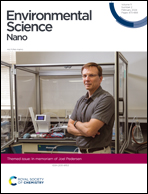Understanding the reaction mechanisms of nicotinamide adenine dinucleotide (NADH) with lithium cobalt oxide and other metal oxide nanomaterials†
Abstract
High-valent metal oxides such as LiCoO2 and related materials are of increasing environmental concern due to the large-scale use in lithium-ion batteries and potential for metal ion release into aqueous systems. A key aspect of the environmental chemistry of these materials is the potential role redox chemistry plays in their transformations as well as their influence on the surrounding environment (i.e., biomolecules, organisms etc.). In recent work, we showed that LiCoO2 (a common lithium-ion battery cathode material) oxidizes nicotinamide adenine dinucleotide (NADH), an essential molecule for electron transport, and enhances Co release from LiCoO2. In the present work, we investigated the mechanism of interaction by examining the role of the ribose, phosphate, adenosine, and nicotinamide components of NADH in the transformation of LiCoO2 nanoparticles. To build an understanding of the interaction mechanism, we used fluorescence spectroscopy to measure the changes in redox state and inductively coupled plasma-mass spectrometry (ICP-MS) to measure the changes in dissolved Co. Our results reveal the importance of surface binding, via the phosphate functionality, in initiating the redox transformation of both LiCoO2 and NADH. Observations from X-ray photoelectron spectroscopy (XPS) data show that molecules containing phosphate were bound to the surface of the nanoparticles and those without that functionality were not. We further established the generality of the results with LiCoO2 by examining other high-valent transition metal oxides. This surface binding effect has implications for understanding how other phosphorylated species can be transformed directly in the presence of high-valent metal oxide nanomaterials.

- This article is part of the themed collections: Nano-bio interactions and Environmental Science: Nano Recent HOT Articles


 Please wait while we load your content...
Please wait while we load your content...